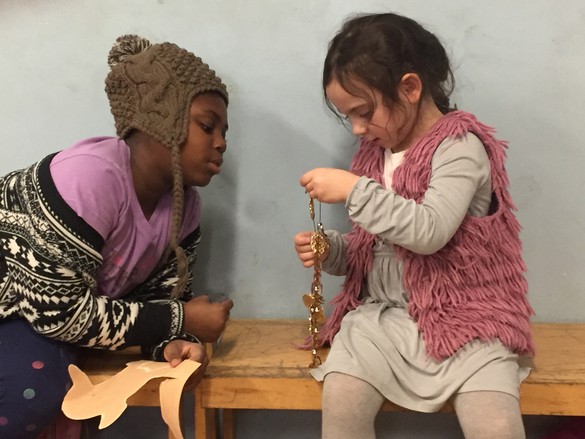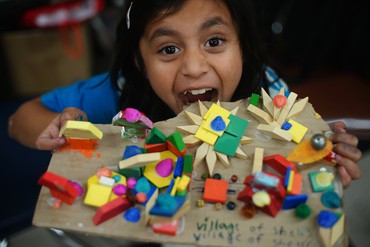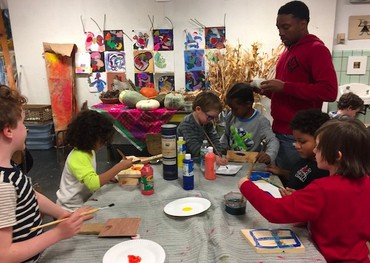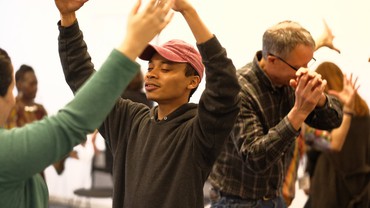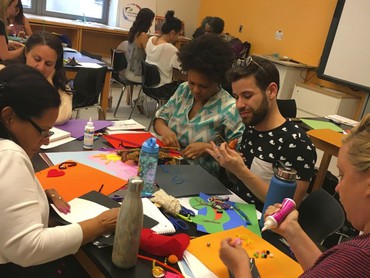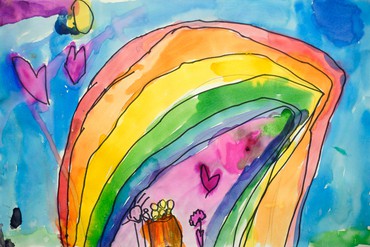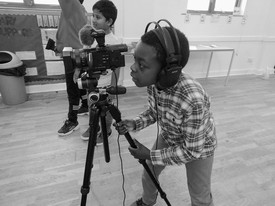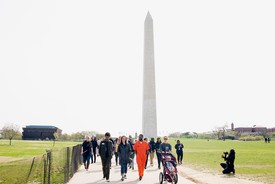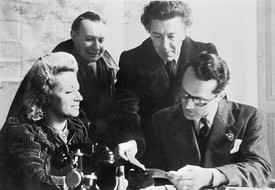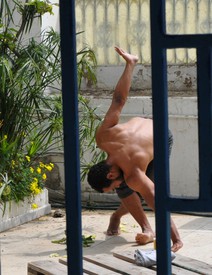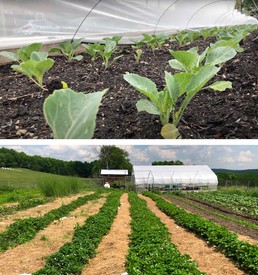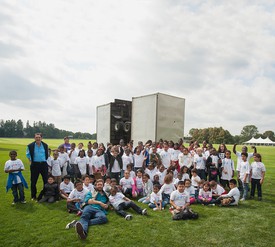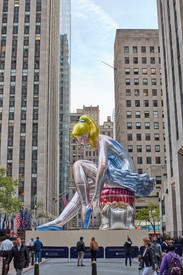
Alexander Kopelman is co-founder, president, and CEO of the Children’s Arts Guild. A writer and advocate who has devoted over thirty years to advancing social justice and personal empowerment, he has a special passion for supporting young people in overcoming the limiting effects of outmoded societal stereotypes on individual development. Prior to founding the Children’s Arts Guild in 2010, Alex served as the director of marketing of Girls Inc., the premier girls’ empowerment organization in the US and Canada.
Jennifer Knox White Alex, how do you describe the Children’s Arts Guild to someone who is unfamiliar with what you do?
Alexander Kopelman I start with our motto: we help children master the art of growing up. People often think about visual arts or performing arts when they hear the word “art,” and what we’re really talking about is the art of living. There is a degree of creativity and joy that’s required in living a good, full life, and that’s what we want to help kids both master and, to some degree, retain.
We deeply believe that each of us is creative in our own individual way, and that socialization narrows our creative abilities, as well as our ability to recognize creative skills in ourselves. And what we endeavor to do is to help children see those parts of themselves and to work on building on them as they grow into the adults that they want to become.
JKW How does the Guild go about this work?
AK It’s multifaceted, but we are primarily focusing on helping educators bring these ideas into their daily practice. Increasingly, the education field has been recognizing that education is much more than just sharing information and helping children master subject areas; it’s also about helping them grow into full people. We believe that the key to that is helping children feel comfortable in their skin and building the skills to continue to feel comfortable as they grow up. We refer to this approach as authenticity-based social-emotional learning. Creativity is key to this—and again, by creativity I mean exercising an intellectual stance towards life and life’s problems—because it allows flexibility. It’s the idea that I can take my experiences and process them in interesting ways that suit who I am as a person.
JKW Could you talk a little about what you mean by authenticity in this context?
AK It’s about being comfortable with yourself, but also about being able to step outside yourself and ask some critical questions, like, “Is the way that I am in the world congruent with my beliefs? Does the way that I show up reflect the person I want to be?” It’s not simply feeling okay about yourself; it’s also beginning to think, “Who do I want to be and how do I get there?”
The Guild grew out of an interest in addressing the limits that gender socialization places on both girls and boys, particularly the way it narrows their expectations of themselves and their opportunities in the world; it restricts who we believe we can be. I worked with Mark LaRiviere, who is an arts educator and artist, and Jim Gaines, who is an early childhood educator, and we developed this idea of creativity in education as a way into the conversation with children about what’s happening for them on the inside, and where the stereotypes around gender limit them. It uses creative expression as a way of engaging children in conversation about their experiences.
JKW What programs does the Guild offer?
AK The main focus is our Authenticity in the Classroom program, which is a professional development program for educators. There are many strands to that: there are trainings on the whole concept; we’re developing partnerships with schools that want to integrate an authenticity-based social-emotional learning approach into existing curriculum; and we also do quite a bit of work on self-care training for educators. We’ve found that educators feel a great sense of pressure to bring social-emotional learning to their students, particularly in regard to helping children deal with their own stress, and it’s all about role modeling: you really have to be able to show up as an authentic person in the classroom to be able to demonstrate to your kids what that looks like—what interacting with the world in an authentic way means. So we’re doing a lot of work around self-care and preparation. We do everything from weekend-long trainings to a two-month course with the New York City Department of Education professional development program this summer, to speaking and presenting workshops at conferences where educators gather, for example at SXSW EDU this past March.
There is a degree of creativity and joy that’s required in living a good, full life, and that’s what we want to help kids both master and, to some degree, retain.
Alexander Kopelman
We also operate a couple of after-school programs and offer workshops for parents. The after-school programs allow us to put into practice all of our ideas and to see how the children interact with them, while observing what kind of training and support the facilitators who work with the children require. The programs for parents are a smaller component of the overall programming. The workshops are designed to help parents think about their children as authentic beings, how to be more present to their own authenticity in parenting, and how to use creativity tools in engaging children in communication.
Last, we are finding increasingly that there’s an appetite among corporate audiences for workshops on authenticity, self-care, and creativity for employees, as a way of building community, and building people skills, the “soft skills” that employers often want in their employees, so we’re doing some interesting work around those kinds of programs.
JKW To take one example of the Guild’s programs, what does a workshop for educators look like? What might someone who enrolls in an Authenticity in the Classroom workshop expect?
AK What often happens with professional development is that educators are handed a curriculum, they get a little bit of training, and then they need to try to figure out how to incorporate it into their already very busy day. So the way that we’ve structured our programming is by first introducing a conceptual framework and then working with educators on developing a plan for how to incorporate that into the curriculum they have to teach. The emphasis is on taking ownership of the ideas and practicing with the material that they’re already teaching to see how the notion of inviting children’s experience into the learning process works with that material.
There are three areas that we concentrate on: we introduce participants to the ideas; we begin to work with them on planning, using something called an empathy map, which is a way of envisioning the kind of classroom culture teachers want to create for their students; and then we work with them on creating a plan for inviting the students into that kind of classroom, and focusing on the support they will need and, with that, the partnerships they will need within their school and possibly outside of school. In other words, “What is the community that I need to be a part of?”
JKW Could you describe how an educator might integrate authenticity-based social-emotional learning into their curriculum? How does this approach look in a classroom?
AK Let’s say the class is reading a book. Very often, the traditional approach is to ask the students to analyze what’s happening in the narrative and to write about that. The authenticity approach is to ask them how what’s happening in the book relates to their own experience—for example, “Is there a portion of what you’re reading that you really relate to because it’s something that has happened to you or someone who’s close to you?”—and then ask them to write about that. What we find is that when you invite that personal connection, children respond in a much deeper way, and not only to that invitation but to the text itself. It humanizes learning, in a way, because it’s now about them, as much as about the character that they’re reading about.
What we encourage educators to do is to incorporate different modes of expression in that process—so maybe inviting the students to make a drawing that says something about the experiences that they share with the character, and then to write something about the piece of art they made. We find that the iterative process of telling the story through different modes and materials opens up the way that children respond. The stories get deeper, because you’re engaging different parts of the person in the process.
JKW Other than the workshops presented at national conferences, are the programs all based in New York?
AK We’re New York City–based for the moment. We started in 2011 with the after-school programs and have been expanding ever since. The goal is to roll out the Authenticity in the Classroom program nationally, starting with five areas across the country. We will start with the self-care workshops for educators, and then begin to offer the broader programmatic trainings in those cities.
JKW That’s wonderful. And the Guild is hosting a conference later in the year?
AK Yes, this will be the fourth annual Children and Authenticity conference. It’s on November 9 and 10, here in Manhattan. The theme this year is “Bringing Love to School.” This came out of our recent speaking engagements, where the word “kindness” kept coming up when we asked, “What do you want people to feel in school?” So the questions we want to focus on are: What does it mean for children to feel loved and accepted? And how does that change education?
JKW Other than the conference, how can people can get involved with the Children’s Arts Guild and support your mission?
AK We just launched a “sponsor a teacher” initiative, which allows people to help individual educators participate in our programs.
If someone is interested in learning more about our work, we always encourage them to come and visit a program. Our after-school program is very good for that, because they get a chance to really see the approach in action. If they’re more interested in the visual arts, they can come and visit an art lesson in one of our Creative Classrooms schools. They’re always welcome to sit in on one of our workshops for educators, too. We post all of the programs on our website, and the conference, of course, is open to the public.
We also have smaller events. We do at least one exhibition of children’s artwork from our programs each year, a self-portraits show, usually in March or early April, that is free and open to the public; this has been held at the Manhattan campus of St. John’s University for the past three years. We are hoping to do more of these. And we host fun events for people to come out and learn about the Guild—like the musical evening we’re hosting on June 27. We believe in practicing what we preach about community, so this is a way for people who are interested in what we do to come and have fun with us. It’s an easy-going way to learn more about the work of the Guild and our philosophy, to meet some of our board members and friends—to dip a toe into the community.
Children’s Arts Guild Summer Musical Soirée, Vini e Fritti, New York, June 27, 2019, 6pm; for information, email contact@childrensartsguild.org
All images courtesy Children’s Arts Guild
